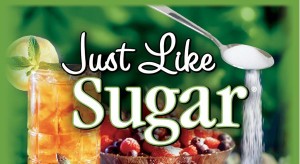Sweet Week-Marketplace Sweeteners
Going to the market to buy a handy sweetener and you most likely are overwhelmed. So many line the shelves. Which do you choose? Here is a list of the more common ones found on the market today with a little blurb to better help you decide.

Just Like Sugar looks and tastes a lot like sugar and has a very low glycemic index. It contains chicory root which has a lot of benefits. It is composed of prebiotic fibers that have been shown to help with candida-cleansing and weight loss. Use it cup for cup in replacement of sugar in any recipe, even ice cream. It also helps increases feeling of fullness since the carbohydrates in the product are all a fiber! You will find this one on our list of sweetener favs!
Stevia in the Raw – This is NOT the same as regular stevia (which I will cover tomorrow). The “Raw” part of the name is very deceiving and totally a marketing tactic for those who go out and buy stevia without looking at the ingredient list. This one’s frist ingredient isn’t even stevia – it’s a chemical sugar. It used to be Dextrose but today I looked and it has Maltodextrin was listed first in the ingredients, both very harmful artificial/chemical sugars. (Read More) They also add a “bulking” agent (splenda does the same thing) to make the sweetener work cup for cup like sugar. This bulking agent is basically carbohydrates.
Monk Fruit To Go – I just picked this one up at WalMart. I bought the “to go” size which is a great little size perfect for your purse or to take on a flight. Monk Fruit is s similar to stevia without the bitter glycoside. Although it contains Sodium Benzoate and Potassium Sorbate (preservatives), it’s listed listed last on the ingredient list which means it is a lesser amount than what is listed first. First listed is water followed by Monk Fruit Extract.
Agave Nectar – Although I used to use and write about the health benefits of raw blue agave nectar, I have since changed my mind after the processing in the USA has changed. If you do want to use agave, there is a natural unprocessed agave product that is made in Mexico – miel de agave, which is a molasses-like syrup made by boiling the agave sap. It’s hard to find but I did see it at Whole Foods and very expensive.
The following sweeteners all use sugar alcohols in their product. Read more on the basics of sugar alcohols here.
 Swerve – One of the newer ones on the market. It’s pretty much just erythritol. So if you feel ok about sugar alcohols, then Swerve would be no different. Again, erythritol causes a laxative effect because the chemical compounds in the sweetener are not completely absorbed into the digestive system. If you choose to use this, do so in moderation.
Swerve – One of the newer ones on the market. It’s pretty much just erythritol. So if you feel ok about sugar alcohols, then Swerve would be no different. Again, erythritol causes a laxative effect because the chemical compounds in the sweetener are not completely absorbed into the digestive system. If you choose to use this, do so in moderation.
Nectresse – Splenda’s latest sweetener. I’m not a fan of Splenda (read more) and personally would not consume one of their products. The first and most abundant ingredient in Nectresse is erythritol. This sugar alcohol is commonly derived from genetically modified corn. Other ingredients: weet Monk Fruit Extract blended with sugar and molasses. Monk Fruit Extract is safe to consume – in the little research I have done, I’ve found nothing about monk fruit that I have seen which would suggest that it is unhealthy or has any negative side effects.
Truvia it is a blend of Stevia, Erythritol and natural flavors. Again, Erythritol is classified as a sugar alcohol so always use in moderation and pay attention to how it effects your body. Sugar alcohols are not completely absorbed into your body and therefore can cause gas and bloating. It’s gaining marketplace popularity and I’ve even seen this one show up as a sweetener choice at coffee shops.
Although I cover these in my Sweeteners to Avoid post, here are a few more you will find on the market today.
Splenda is made with chlorine components. The presence of chlorine is thought to be the most dangerous component of sucralose. Chlorine is considered a carcinogen and has been used in poisonous gas, disinfectants, pesticides, and plastics. Short-term studies done by Splenda’s manufacturers, McNeil Nutritionals, revealed that test rodents suffered from dangerous side effects such as shrunken thymus glands, and enlarged livers and kidneys. No long-term studies were done before Splenda was approved by the FDA. Read more on Splenda here.
Equal or NutraSweet both contain aspartame which has been linked to numerous health issues including, but not limited to, headaches, mood swings, neurological disorders, seizures and even brain tumors. This harmful ingredient breaks down into phenylalanine when it is ingested and metabolized. Phenylalanine causes excessive action of neurons in the brain and it kills cells. Aspartame turns to formaldehyde at 80 degrees, which obviously is a lower temperature than our bodies. Research has shown that too much phenylalanine can trigger Attention Deficit Disorder, Hyperactivity Disorder, as well as emotional and behavioral disorders. Read more: Could Aspartame Be Making You Sick?
As always, you need to choose a sweetener based on what you personally choose to put into your body. We strongly encourage all sweetener use to be in moderation.
Up next in “Sweet Week”:
Choose your Sweetener Wisely – Our Faves
How to Pick a Sweetener for you, your family and your healthy lifestyle
Don’t miss previous Sweet Week posta:
Sweeteners to Avoid
Sugar Alcohols – To use or not to use


